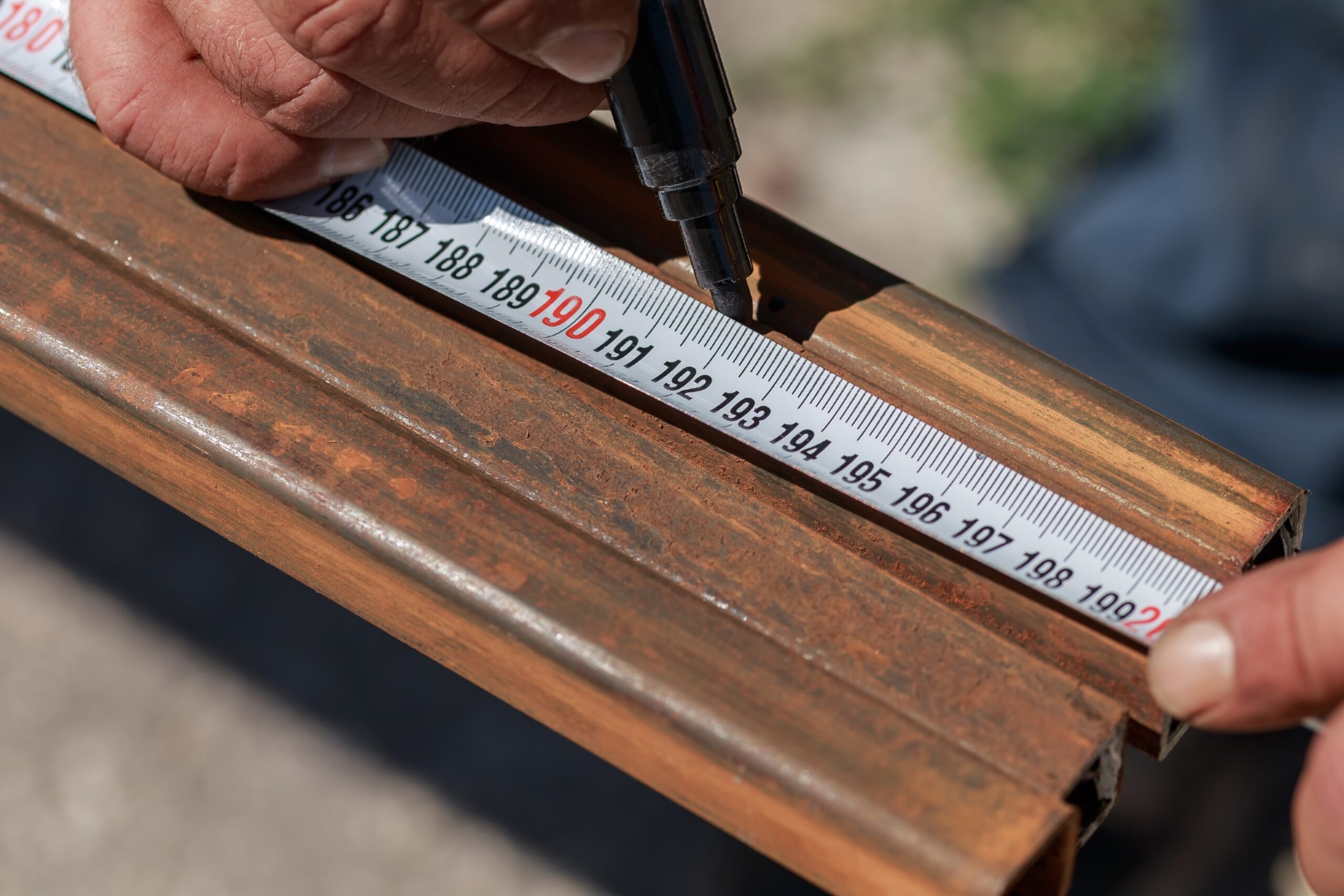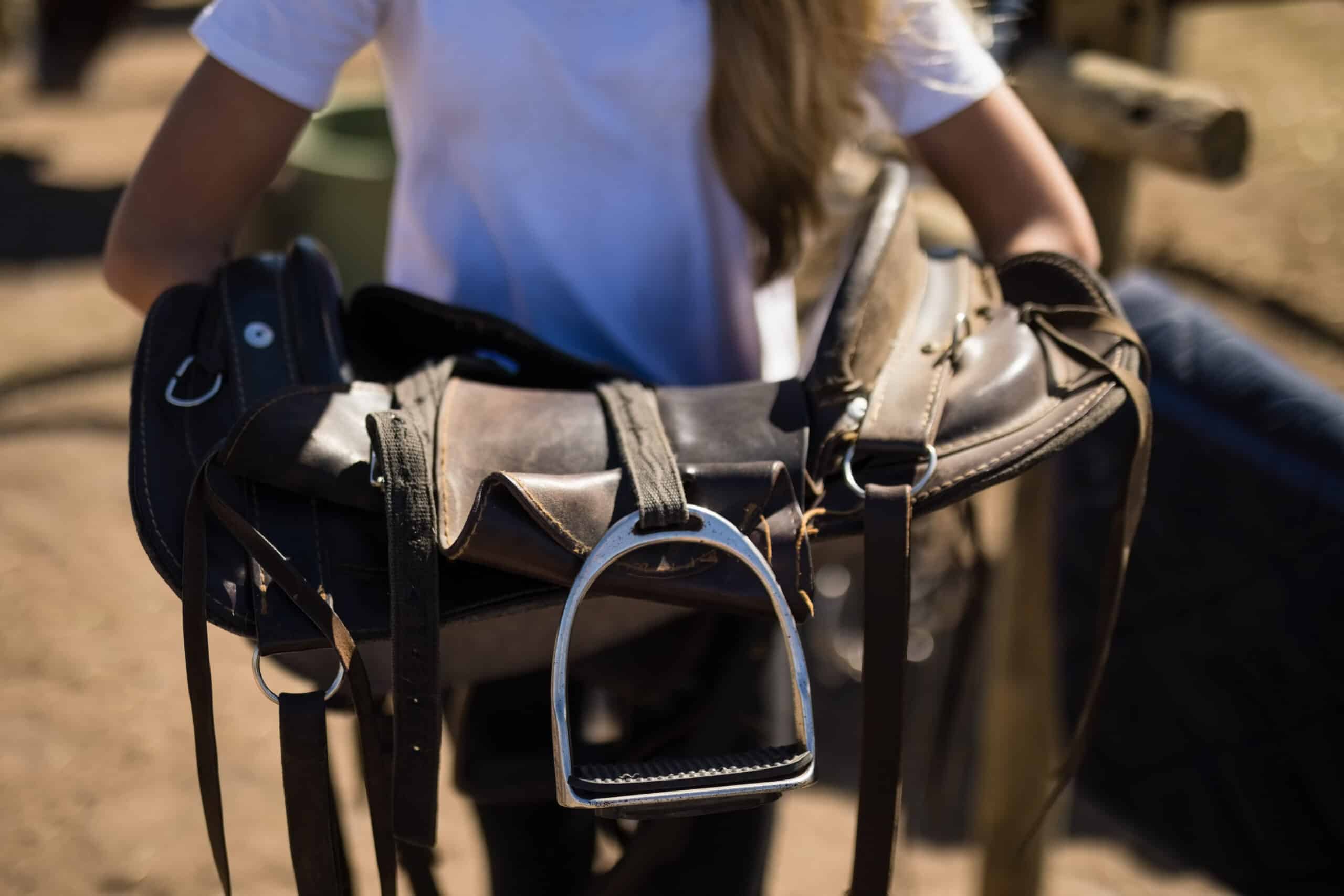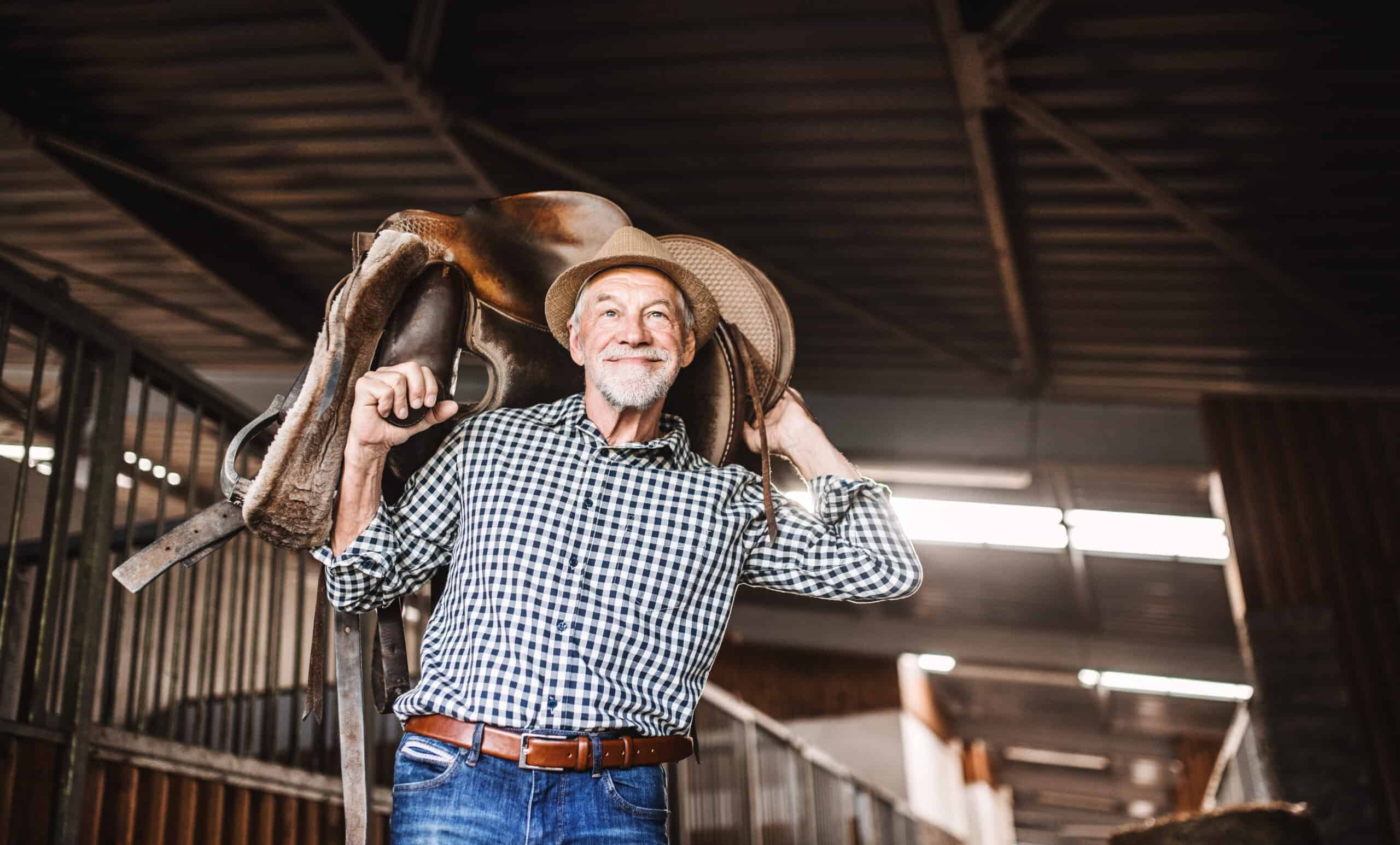Knowing how to saddle a horse is one of the fundamental skills of horseback riding. The process itself is fairly simple once you become familiar with each step.
The first steps are to place a saddle pad and the saddle onto the horse’s back. Next, secure the girth to keep the saddle in place. Adjust the fit and stirrups as needed.
In order to avoid injuring yourself or the horse, it’s critical to learn the best practices for each of these larger steps. Putting on Western saddles and English saddles will follow slightly different processes.
The goal of learning how to properly put on a saddle is ensuring that you’re secure and that you and your horse are comfortable with the saddle. If you fail to properly put on a saddle, you might fall off or cause your horse pain.
You should also take care to choose the right tack for each horse. Not all horses are alike. For example, one horse’s withers may require a longer saddle than another of the same breed and height. A saddle that isn’t adjusted to the right fit can strain a horse’s spine or irritate the horse’s skin from the saddle moving around too much.
After learning how to saddle a horse, you can move on to other tacks like a bridle or breast collar. Not everyone chooses to ride in both disciplines, but it can be handy to know how to use different types of tack even if you’re firmly committed to only riding in one style.
Preparing For A Ride
There are some parts of preparing for a ride that are common between English and Western disciplines. For one, it’s important to prepare yourself and your horse for a ride to prevent injuries and ensure all equipment is working as it should.
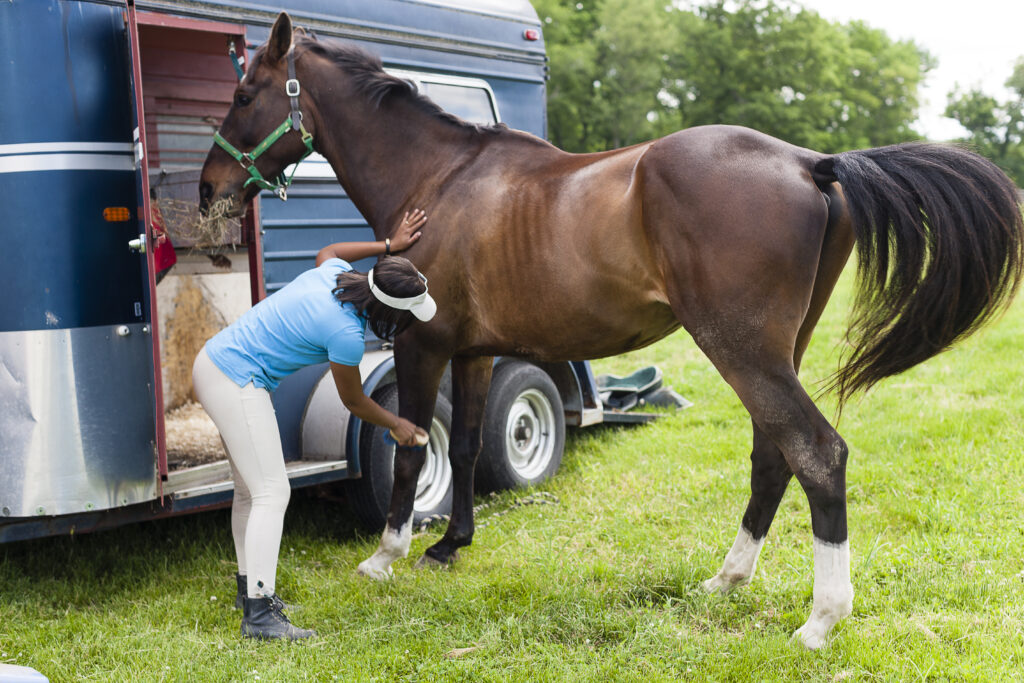
A key first step is to ensure that your horse is properly groomed with a curry comb and brushes. Any dirt or caked mud should be removed before saddling up. A curry comb helps free dirt from your horse’s coat, and a stiff brush can be used to remove it. A soft brush can bring out the oil in the hair and remove any fine dust that’s left.
While you’re grooming your horse, look for any signs of skin irritation on the horse’s back, girth area, and shoulder blades. Look for signs of saddle sores, such as discoloration, loose hair, redness, or swelling from pressure points.
Next, choose your tack and confirm that it’s in good condition for riding. This includes getting the saddle you need, as well as saddle blankets or pads, a bridle, and a girth strap. If you use a breast collar or horse boots, collect those as well.
Don’t forget to bring along your own equipment. You’ll need your boots and helmet in addition to any other items you may prefer to bring along, such as a riding crop or saddlebags.
Saddling For Western Riding
Learning to saddle a horse Western style is fairly straightforward. A Western saddle and an English saddle aren’t significantly different. The former is made for activities like roping, ranch riding, or barrel racing, while the latter is designed for events like jumping and dressage.
Once you’ve gathered your materials and finished any preparatory steps, place the saddle pad or blanket onto the horse and ensure that it’s in the correct position. Move the cinch and the right stirrup out of the way or drape it around the saddle horn to keep it from smacking into the side of your horse when you put the saddle on.
Place the saddle on the horse’s back over the blanket or pad. The saddle should sit so that the cinch is just behind the horse’s front legs. At this point, you can bring the stirrup and cinch down from on top of the saddle.
Move back to the left side of the horse and secure the cinch to the D-ring on the saddle with the latigo cinch strap by looping it repeatedly through both rings. About a foot of extra length should be left when you’re finished.
Secure the back cinch if your saddle has one. This part of the saddle is distinct to Western riding since English-style saddles don’t have a back cinch.
Check that the cinch straps aren’t too tight on your horse. If they are, loosen and start over until you’ve found the right amount of tension to secure the saddle without making your horse uncomfortable.
Saddling For English Riding
The process to put a saddle on a horse is slightly different from an English-style saddle. As you prepare, remember to inspect all your tack and materials before you start. You should also look over the horse’s shoulders and the horse’s stomach for signs of saddle sores or other conditions on the horse’s body.
Once you’ve put the bridle on your horse, it’s time to address the saddle. Start by putting on the pad or blanket. Most English riders prefer to work from the left side.
If you’ve already moved the stirrup irons up on the leather straps, you can place the saddle gently onto the saddle pad. If not, move the stirrups up the leathers to keep them from hitting against the horse’s sides when you put the saddle on the horse.
Next, secure the girth strap to the girth billets on the left side of the saddle. Run the girth strap from the horse’s left side to the right and then secure the strap there as well. With English saddles, there is no back cinch.
Tighten the girth strap to the horse’s belly, but make sure that it isn’t too tight or in the wrong location. A girth strap that’s even slightly forward or slightly back from where it’s supposed to be can cause pain or irritation.
Once the saddle is in place, test it to make sure that it’s secure. Don’t forget to bring your stirrups back into place and check that you have the right stirrup length for riding.
Horse Saddle Accessories
Breast Collars
Breast collars are used in English and Western riding, but they’re more popular with Western disciplines. The idea behind a breast collar is to keep your saddle from sliding or moving back while riding.
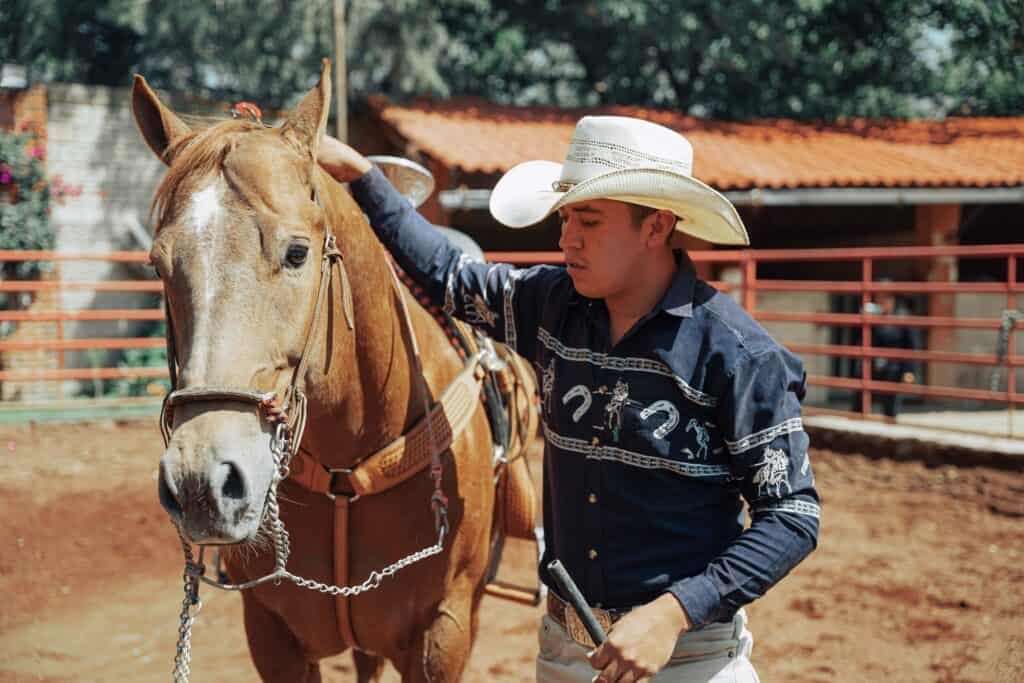
The collar is simple to put on because it attaches to the saddle with a D-ring on each side, has loops on the end to fit around the girth, or connects to the rings on the cinch. The exact design and attachment method will differ based on the saddle you’re using. Not every saddle includes D-rings in the front for this purpose.
Once you have the breast collar in place, check that it’s secure on the horse. It shouldn’t be too tight or keep your horse from moving properly. Pay close attention to the shoulder area and confirm that you can easily fit your hand in between the breast collar and your horse’s skin.
In Western riding, these collars are often broader and thicker. It’s also common for them to have decorative tooling and other adornments.
Cruppers And Breeching
Just like a breast collar, a crupper is designed to help keep a saddle in place. A crupper is a small strap that loops under a horse’s tail, extends over the rump, and attaches to the saddle to keep it from accidentally sliding forward while riding.
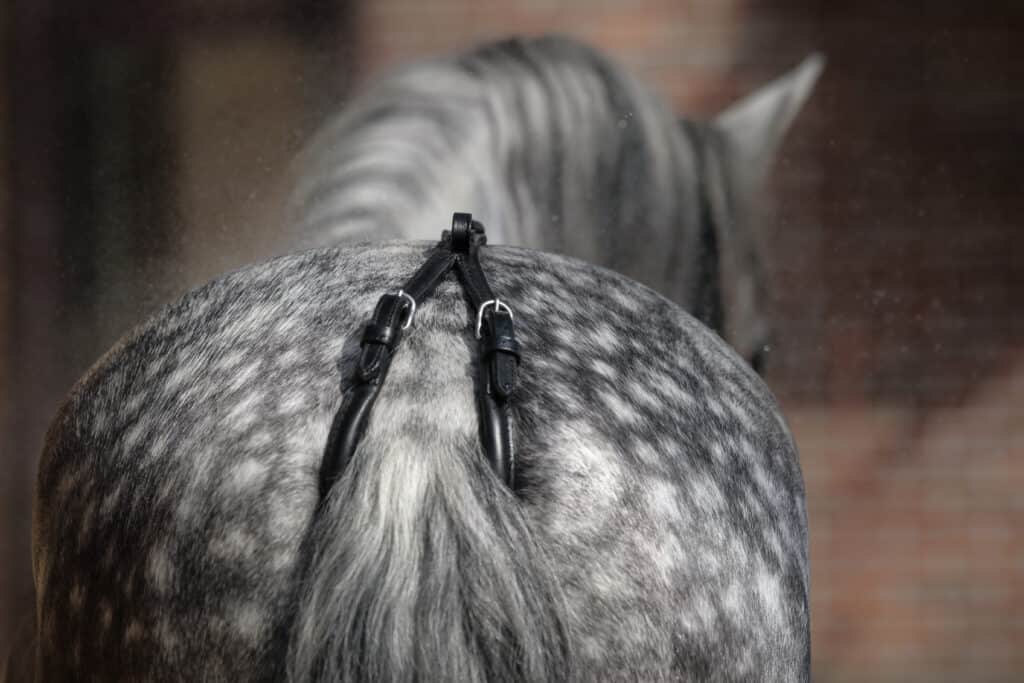
Cruppers can have a single point of attachment or a double attachment. They’re commonly made of soft leather to ensure that they’re not irritating to the horse while worn.
When putting on a crupper, check to ensure that it isn’t too tight or too loose. If there isn’t enough space for the horse to move without causing friction against the crupper, it can cause skin irritation and pain around the tail.
If the crupper is too loose, it won’t be effective in preventing sliding. A good rule is to see whether you can fit two fingers in between the crupper and your horse’s body.
Breeching, also known as britchen, may also be used with a saddle that has double attachment points, but it’s far more likely to be used with harnesses instead of traditional saddles. Breeching is similar to a crupper but runs around the back of the horse’s thighs.
Breeching should sit at the widest part of the thigh area. This will prevent it from moving up under the tail or falling down where it could cause the horse to stumble. Breeching often includes a crupper, but there are standalone designs as well.
Saddlebags
Bags are essential for riding long distances or for extended periods of time. They’re particularly important for ranch work since riders are more likely to need extra equipment or tools.
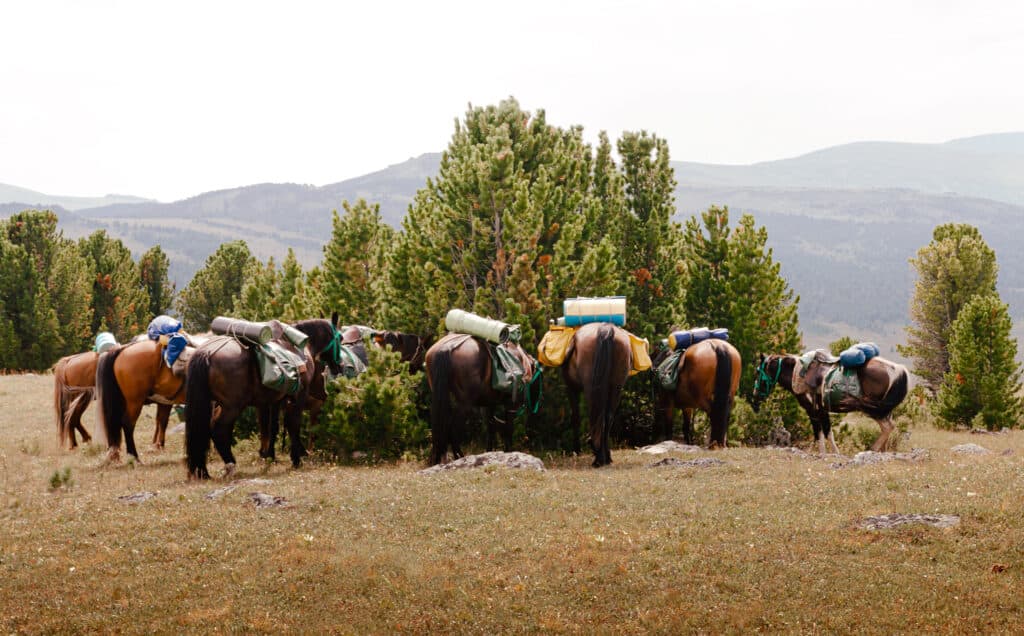
Attached saddlebags are more common with Western-style saddles where bags can be secured to D-rings by either tie strings or clips. However, some cantle and pommel bags are designed to work with an English saddle.
Clips are the easiest attachment method because they secure directly to the D-rings without any tying required. With ties, you should use a simple knot that you can easily take on and off.
Before you go on a long trip, check that your bags aren’t going to cause your horse pain. An uneven load could cause your horse to feel off balance.
Obviously, larger horses will be able to carry more than smaller horses. Consider your own weight as well while calculating how much your horse can safely carry over the intended distance.
If you’re riding with more than one horse, consider breaking up the load so that each horse carries some equipment or materials. This will ensure that one horse isn’t working harder than the rest from carrying extra pounds.
Final Thoughts
Learning how to put a saddle on a horse is often challenging for beginners, but most people are able to learn English-style and Western-style tack within a short time.
Saddling a horse involves inspecting your horse and equipment, putting the saddle pad and saddle in place, and securing the girth or cinch. The second part is confirming that the stirrups and the fit of the saddle are right for you and your horse.
Most horses are quite patient and forgiving. Once you learn the basics of how to put on a saddle pad and saddle, you can expand into putting on other items like bridles, horse boots, cruppers, or a breast collars.
The most important thing is to check that you and your horse can safely ride before departing. The last thing you need is to be miles away from help only to realize that your saddle is damaged or you failed to notice that your horse has an injury.
Frequently Asked Questions (FAQ):
How Heavy Is A Saddle?
An average Western saddle will be around 30 pounds, while an English saddle will usually be in the range of 15–25 pounds. The exact weight will vary based on the design, especially with a Western saddle since they tend to be heavier and larger than English models.
With extremely heavy saddles, a smaller rider may struggle to lift the saddle, which can pose a problem while saddling a horse. The same is true while managing taller horses since you will have to lift the saddle higher to reach the horse’s back.
Is It Difficult To Saddle A Horse?
It’s not difficult to saddle a horse once you’re used to the process and familiar with all the tack involved. Beginners may struggle to remember the order of steps and perfect the amount of tension needed in the girth to ensure a snug fit.
This will become second nature with a little practice. While learning, it can be best to choose horses that are calmer and used to wearing a saddle.
What’s the Difference Between Putting on a Western and English Saddle?
The major difference between saddling up in the different disciplines is how the saddle is secured. Western saddles have a front cinch and back cinch. The saddle is held securely by the front cinch knot, and the rear cinch plays a secondary role to stabilize the saddle.

